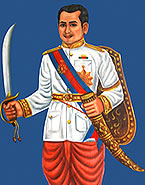Tra Sek village (Tra sek commune, Jroyyuor district, Sóc Kleang province) is home to over 3,000 people of three ethnic groups: Khmer, Hoa, and Viet. The Khmer make up the largest part, at 60% of the total population.
Trasek village is situated on a high area along the windy and salty coast, “so we have only one rain-fed rice crop every year,” explains Son Linh, 78 years old. However, “most of the villagers still closely connect their life to the paddy fields and rice cultivation, growing shallots and tobacco plants,” Son Linh continues. A small number of villagers live on trade, or fishing along the coast.
Whether wealthy or poor, growing shallots or tobacco plants, working in agriculture or fishing, villagers always try their best to contribute their labour and donations to build an impressive and beautiful Buddhist temple.
The village Buddhist temple, where people “send their property when they are alive and their remains when they die,” is not only for Buddhist rituals but also the centre of cultural activities, where writing and moral lessons are taught.
VietNamNet Bridge – A small room filled with wooden statues serves as a gallery for cultural features of the Khmer people and an ambition to preserve the culture of the Khmer of Son Kinh.
Son Kinh, a 78-year-old artisan of Bung Chong Hamlet, Tai Van Commune, My Xuyen District in the Mekong Delta province of Soc Trang, has 50 years of experience as a carver. His works are made in shapes of animals such as dinosaur, deer, horse, monkey, birds, tiger, elephant and snakes, as well as shapes of musical instruments of Khmer people and weapons for actors on stage.
His strong passion for art developed when he was young. He went to the forest and took stumps and carved them in shapes of animals. He also spent seven years learning the art of carving from the monk Luc Ta Pech at Baichhau Pagoda in My Xuyen District
After getting married, he became a rice farmer and continued his ambition to create worthy and interesting works. With his talented hands he turned stumps and waste pieces of wood into works featuring cultural features of the Khmer people, including the statues of Si Ta Princess, Hanuman monkey and towers and characters of Ro Bam stage. Some his works are displayed in local pagodas such as Baichhau, Ta Mol, bung Sa.
“I’m absorbed in art; I will teach anyone who wants to learn without payment. I hope the young generations will preserve the Khmer people’s culture,” said Son Kinh.
His dream came true when his son Son Kol, 40, and his nephew Son Nhat Anh, 12, became interested in carving art and started studying with him.


















0 comments:
Post a Comment